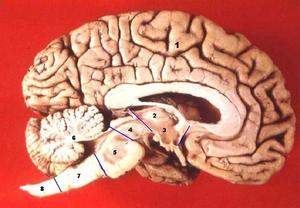Mental retardation is defined as an IQ (intelligence quotient) of less than 70. A person with an IQ between 70 and 79 is said to have borderline intellectual functioning. An individual’s IQ is determined through testing and comparison to a deviation IQ scale. For gross simplification, IQ can be calculated as a child’s mental age divided by their actual chronological age multiplied by 100.
For example, a 10 year old boy with who has the mental capacity of a 3 year old has an IQ of (3/10)*100, or 33.
There are gradations of mental retardation that define how severely an individual is affected by their condition. These include mild, moderate, severe, and profound retardation.
Mild mental retardation is an IQ between 55 and 69.
-These individuals can live independently and can work jobs in highly structured environments.
Moderate mental retardation is an IQ between 35 and 54.
-These individuals require significant support to live semi-independently and may live with their parents or in a group home as adults.
Severe mental retardation is an IQ between 20 and 34.
-These individuals can learn basic self-care and may be able to do simple tasks with supervision.
Profound mental retardation is an IQ less than 20.
-These individuals require constant care because they cannot protect themselves from physical dangers.
The most common causes of mental retardation are Down’s syndrome, fetal alcohol syndrome and in boys, Fragile X Syndrome.
Down’s syndrome is most commonly the result of trisomy 21 (three copies of chromosome 21). Individuals with Down’s syndrome may congenital physical abnormalities including duodenal atresia, esophageal atresia, hirschsprung’s disease, and ventricular septal defect (VSD), thyroid disorders and other heart defects. There is an increased incidence of Alzheimer’s disease and leukemia in Down’s syndrome.
Fetal alcohol syndrome is the most common preventable from of mental retardation. Many affected individuals are mildly retarded and have a characteristic facial appearance consisting of a smooth philtrum, thin upper lip and small palpebral fissures.
Fragile X syndrome is an x-linked defect that shows up in males. It is associated with large testes and long face with a large jaw, large everted ears and autism.
Other causes of mental retardation include, but are not limited to:
-Imprinting errors:
Prader-Willi syndrome is due to deletion of a normally active paternal allele.
Angelman syndrome is due to deletion of the maternal allele.
-Autosomal dominant inheritance:
Tuberous sclerosis is characterized by seizures, facial lesions (adenoma sebaceum), hypopigmented skin spots, retinal hamartomas, renal angiomyolipomas, cardiac rhabdomyomas, and increased incidence of brain astrocytomas.
-TORCH infections:
These include toxoplasmosis, rubella, cytomegalovirus (CMV), herpes simplex, syphilis, Hepatitis B, HIV, Parvovirus B19, Varicella-Zoster virus. Often, the mother has few or no symptoms.
-Trisomies (triple chromosomes):
Edward’s syndrome is Trisomy 18, recognized by micrognathia, clenched hands and often rocker-bottom feet
Patau’s syndrome is Trisomy 13, recognized by microphthalmia, cleft lip or palate, polydactyly and often rocker-bottom feet.
-Gene deletion:
WAGR syndrome causes Wilm’s tumors, aniridia, genitourinary anomalies (gonadoblasotmas) as well as mental retardation.
Cri-du-chat syndrome (literally “cry of the cat”) causes microcephaly, epicanthal folds, high-pitched crying, and cardiac abnormalities.



